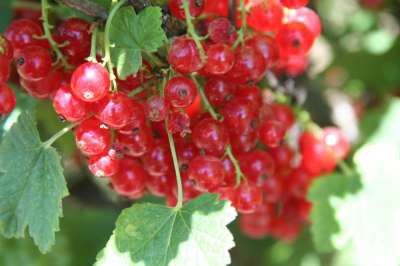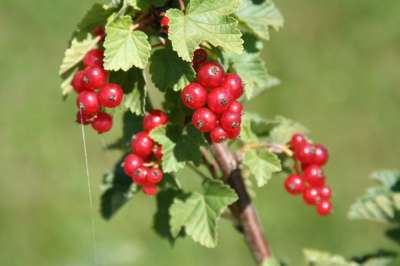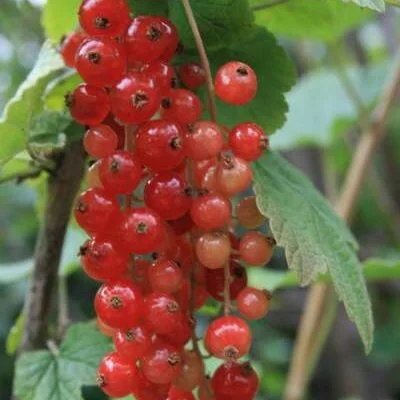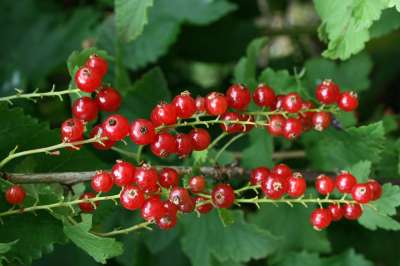Your basket is currently empty!
Initial Pruning for Redcurrants
Redcurrants and whitecurrants do not need the hard pruning that is recommended for Blackcurants and a framework of growth is left in place. Initially the leaders [main stems] can be shortened by up to one third to any outwardly facing bud. This has the effect of keeping the centre of the bush more open which makes the foliage less prone to disease and also makes harvesting easier. You will find the fruiting trusses in the centre of the bush will ripen more readily, and will be sweeter as a result of this type of pruning. This pruning should be done soon after planting. The following winter leading branches can further be shortened to encourage side[fruit bearing] laterals. At this stage any unwanted low branches can also be removed at their base.
By the third year you should have a well shaped and nicely branched bush. From now on the only attention is to continually shorten longer/main branches and remove any that are causing congestion, diseased, or broken.
Click here to buy our quality currant Bushes of Redcurrant
Cordon currants
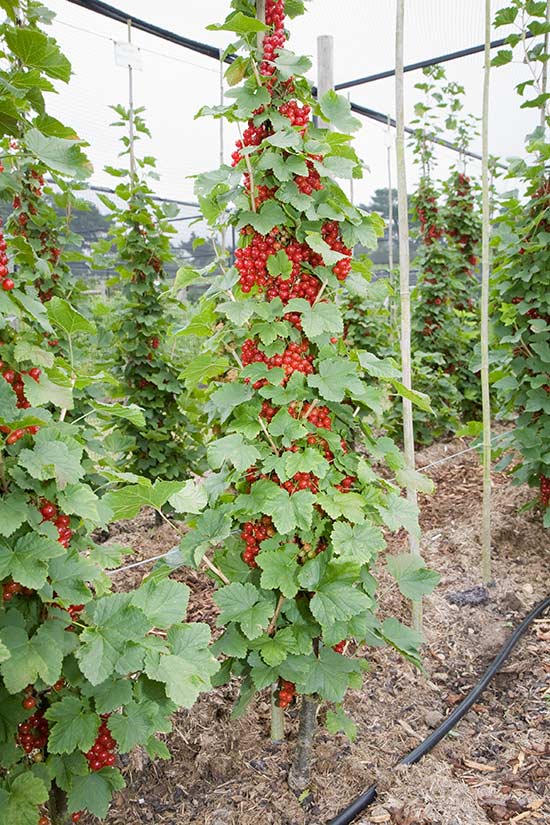
An increasingly popular way of growing both redcurrant and white currants is as the cordon system. This saves a great deal of space in the garden as a single cordons can be planted just 15” apart, with double cordons only 18”-24” apart. A single cordon will have just one main stem with numerous short side laterals coming off it. A double cordon will have two main stems in the shape of ‘V’ so it will produce double the crop but will take more space.
Cordons are quite easy to maintain and the fruits ripen really well with the benefit of all that sunshine and air circulation. They will need some support; a good stout bamboo cane for a single cordon, and two for the double, can be sufficient if you need to grow them in the open and only want one or two specimens. But gardeners often take advantage of the modest planting distance required, two plant a row and thus incorporate more varieties. Gooseberries also can be included here as well. In this case a post and wire system would be more practical, the posts need to be 48” height allowing for burial, and 1 x 1” should be satisfactory. Two straining wires, placed at 24” and 36” is adequate. The cordons themselves will grow quite tall if you let them – heights of up to 6’ are common and that is ok if you want to grow them against a wall but in an open position I would recommend tipping them at 4 or 5’. Of course the taller they are the more crop you will get.
Pruning consists of keeping the main side shoots trimmed back to 4 or 5 leaves in June OR July of each year. These shoots ripen to give fruit the following summer. The leader is left intact at this point.
After 2 or 3 years you will have an established framework which should be maintained by trimming back all laterals [ie. Side shoots] to 1”. The main leader can be trimmed to just above a bud as required. This type of pruning should be carried out from November to February. A second dose of pruning is then required later that summer, this time trimming back those side shoots to 4 or 5 leaves again.
Pests and diseases
With the exception of big bud mite, redcurrant and whitecurrants bushes may suffer from the same pests and problems as blackcurrants, a resume follows here.
Predation from birds
Predation from birds cannot be underestimated and will be much more severe than it is with blackcurrants. Redcurrants in particular are one of their most favourite things and provision should be made to deter them. Growing redcurrants in a fruit cage is a very worthwhile practice to be absolutely sure you get to harvest your spoils. If this is not possible then fastidious netting – making sure there are no holes or pockets that the birds’ can gain access through, as their eyes are much sharper than ours – is the best option. This should be erected just as the very first berries start to colour up. At this point most of the crop will still be green but if you leave it too late then the majority of the berries will be taken just as they start to ‘turn’ colour.
Aphids & greenfly
Are the most commonly troublesome critters, causing soft new growth to curl and become distorted, sometimes it also become streaked with yellow. These insects overwinter on the bush so the first step to eradication is to provide a winter wash all over the bush whilst it is dormant. Insecticides are still very effective but you need to start early, soon after the first leaves emerge and repeat applications as directed by the manufacturer. If you have left it too late and your blackcurrants already show signs of heavy infestation, be prepared to snip off the ends of the new growth where the damage is worst, destroy these growths, and then spray. Unchecked greenfly populations sap the strength of the bush and they also spread diseases.
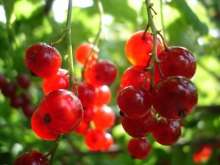
Mildew
This is a fairly commonplace problem with currants and is more troublesome with the older varieties but not exclusively so. The leaves become silvery and powdery and it can spoil the fruits too. Sometimes this fungal disease is encouraged by a lack of pruning as too much congested or soft growth encourages it. It is fairly easily dealt with by a proprietary insecticide [we use systhane but so many are being withdrawn all the time, it’s a matter of what your local stockist can recommend] but again prevention is better than cure so start an early spraying programme to prevent it getting a hold in the first place.
Leaf spot
Begins life as small brown spots on the leaves which gradually become larger and coalesce. Leaves fall prematurely and the resultant crop is usually affected. The disease can be controlled by the use of a broad spectrum fungicide, applied shortly after flowering. Extra feeding is usually effective to help the bushes regain vigour that has been lost.



